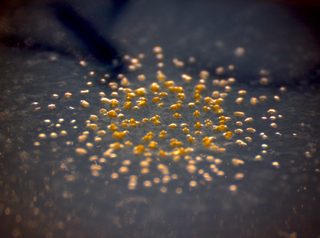
Desulfovibrionales are a taxonomic order of bacteria belonging to the phylum Thermodesulfobacteriota, with four families. They are Gram-negative. The majority are sulfate-reducing, with the exception of Lawsonia and Bilophila. All members of this order are obligately anaerobic. Most species are mesophilic, but some are moderate thermophiles.

Myxococcaceae is a family of gram-negative, rod-shaped bacteria. The family Myxococcaceae covers the best explored and studied myxobacteria with a wide scope of research.
The Aquificaceae family are bacteria that live in harsh environmental settings such as hot springs, sulfur pools, and hydrothermal vents. Although they are true bacteria as opposed to the other inhabitants of extreme environments, the Archaea, Aquificaceae genera are an early phylogenetic branch.
The Erysipelotrichaceae are a family of Gram-positive bacteria.

The Chlamydiaceae are a family of gram-negative bacteria that belongs to the phylum Chlamydiota, order Chlamydiales. Chlamydiaceae species express the family-specific lipopolysaccharide epitope αKdo-(2→8)-αKdo-(2→4)-αKdo. Chlamydiaceae ribosomal RNA genes all have at least 90% DNA sequence identity. Chlamydiaceae species have varying inclusion morphology, varying extrachromosomal plasmid content, and varying sulfadiazine resistance.
The Myxococcota are a phylum of bacteria known as the fruiting gliding bacteria. All species of this group are Gram-negative. They are predominantly aerobic genera that release myxospores in unfavorable environments.
In taxonomy, Methanofollis is a genus of the Methanomicrobiaceae.
The Veillonellaceae are a family of the Clostridia, formerly known as Acidaminococcaceae. Bacteria in this family are grouped together mainly based on genetic studies, which place them among the Bacillota. Supporting this placement, several species are capable of forming endospores. However, they differ from most other Bacillota in having Gram-negative stains. The cell wall composition is peculiar.
Acidaminococcus is a genus in the phylum Bacillota (Bacteria), whose members are anaerobic diplococci that can use amino acids as the sole energy source for growth. Like other members of the class Negativicutes, they are gram-negative, despite being Bacillota, which are normally gram-positive.
Sporomusa is a genus of Bacillota bacteria classified within the class Negativicutes.
Megamonas is a genus of Bacillota bacteria classified within the class Negativicutes.
Megasphaera is a genus of Bacillota bacteria classified within the class Negativicutes.
The Selenomonadales are an order of bacteria within the class Negativicutes; unlike most other members of Bacillota, they are Gram-negative. The phylogeny of this order was initially determined by 16S rRNA comparisons. More recently, molecular markers in the form of conserved signature indels (CSIs) have been found specific for all Selenomonadales species. On the basis of these markers, the Selenomonadales are inclusive of two distinct families, and are no longer the sole order within the Negativicutes. Several CSIs have also been found specific for both families, Sporomusaceae and Selenomonadceae. Samples of bacterial strains within this order have been isolated from the root canals of healthy human teeth.
The Silvanigrellaceae are the only family of the order Silvanigrellales, of the class Oligoflexia, of the phylum Pseudomonadota. This family currently harbors the two genera Silvanigrella and Fluviispira
Planctomycetaceae is a family of bacteria.
Gemmataceae is a family of bacteria.
Pirellulales is an order of bacteria.
Lacipirellulaceae is a family of bacteria.
The Pirellulaceae are a family of bacteria.
Pelagicoccus is a Gram-negative genus of bacteria from the family of Puniceicoccaceae.


